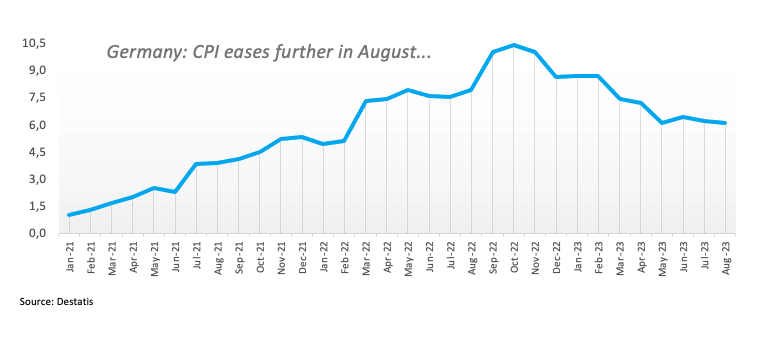Euro keeps hovering around the 1.0700 region

- The Euro fades part of the initial optimism vs. the US Dollar.
- Stocks in Europe now trade broadly on the defensive.
- EUR/USD meets initial resistance around 1.0730.
- The USD Index (DXY) puts the 105.00 region to the test.
- Final August CPI in Germany matched the preliminary readings.
- Wholesale Inventories, Consumer Credit Change come next in the US docket.
The Euro (EUR) manages to gather some upside traction against the US Dollar (USD) on Friday, lifting EUR/USD back above the 1.0700 level at the end of the week.
The Greenback partially retreats from Thursday’s six-month tops north of the 105.00 hurdle when gauged by the USD Index (DXY) amidst some tepid recovery in the appetite for risk assets.
Back to the monetary policy front, speculation over a potential hike by the Federal Reserve (Fed) in November appears to have lost some momentum, while market participants continue to price in rate cuts at some point in Q2 2024.
Regarding the European Central Bank (ECB), market chatter appears to favour a pause at the September 14 meeting amidst a pretty divided Council.
In the euro docket, final inflation figures in Germany saw the CPI rise at a monthly 0.3% in August and 6.1% over the last twelve months, unchanged from the preliminary estimates, while Industrial Production in France expanded by 0.8% MoM in July.
Across the pond, US Wholesale Inventories and Consumer Credit Change data are due.
Daily digest market movers: Euro meets initial hurdle around 1.0730
- The EUR shows some signs of life against the USD.
- US yields appear tilted to the downside early on Friday.
- Investors see the ECB keeping the deposit rate unchanged this month.
- Dallas Fed President Lorie Logan favours a pause in September.
- NY Fed President John Williams expects the Unemployment Rate to increase to more than 4%.
- Markets continue to price in Fed rate cuts in Q2 2024.
- Strikes at Chevron LNG plants kick in today.
- Final GDP Growth Rate in Japan came in at 4.8% YoY.
Technical Analysis: Euro risks a deeper pullback in the short-term
EUR/USD is trading with modest gains in the vicinity of the 1.0700 area on Friday after hitting multi-week lows near 1.0680 in the previous session.
Should the EUR/USD manage to breach Thursday’s at 1.0685, it may retest the May 31 low of 1.0635 before potentially reaching the March 15 low of 1.0516. A breakdown of the latter level could trigger a possible test of the 2023 low at 1.0481 from January 6.
Conversely, in terms of upward movement, the current focus is on targeting the critical 200-day Simple Moving Average (SMA) at 1.0822. Beyond that, bullish momentum may lead to a challenge of the August 30 level at 1.0945, which is further bolstered by the provisional 55-day SMA at 1.0945. Subsequently, this could set the stage for a move towards the psychological level of 1.1000 and the August high at 1.1064. If the pair manages to clear this area, it might alleviate some of the bearish pressure and potentially aim for the July 27 peak at 1.1149 ahead of the 2023 top at 1.1275 from July 18.
As long as the EUR/USD remains below the 200-day SMA, a sustained decline in the pair is probable.
ECB FAQs
The European Central Bank (ECB) in Frankfurt, Germany, is the reserve bank for the Eurozone. The ECB sets interest rates and manages monetary policy for the region.
The ECB primary mandate is to maintain price stability, which means keeping inflation at around 2%. Its primary tool for achieving this is by raising or lowering interest rates. Relatively high interest rates will usually result in a stronger Euro and vice versa.
The ECB Governing Council makes monetary policy decisions at meetings held eight times a year. Decisions are made by heads of the Eurozone national banks and six permanent members, including the President of the ECB, Christine Lagarde.
In extreme situations, the European Central Bank can enact a policy tool called Quantitative Easing. QE is the process by which the ECB prints Euros and uses them to buy assets – usually government or corporate bonds – from banks and other financial institutions. QE usually results in a weaker Euro.
QE is a last resort when simply lowering interest rates is unlikely to achieve the objective of price stability. The ECB used it during the Great Financial Crisis in 2009-11, in 2015 when inflation remained stubbornly low, as well as during the covid pandemic.
Quantitative tightening (QT) is the reverse of QE. It is undertaken after QE when an economic recovery is underway and inflation starts rising. Whilst in QE the European Central Bank (ECB) purchases government and corporate bonds from financial institutions to provide them with liquidity, in QT the ECB stops buying more bonds, and stops reinvesting the principal maturing on the bonds it already holds. It is usually positive (or bullish) for the Euro.
